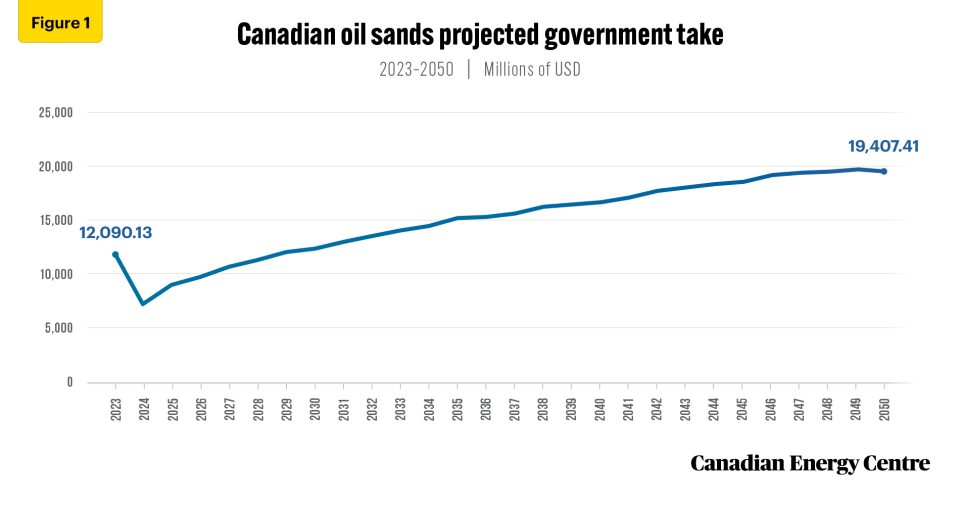Annual government revenues from Canada’s oil sands sector expected to rise to US$19.4 billion in 2050
Follow CEC on Linkedin CEC Linkedin
Follow CEC on Facebook CEC Facebook
Follow CEC on Twitter CEC Twitter

Canada’s parliament building in Ottawa. Getty Images photo
Overview
With ongoing public discussions focusing on net zero emissions from Canada’s oil sands sector, it is a good time to examine projected government revenues and capital expenditures (capex) expected from the sector through 2050. This analysis illustrates how investment in low-emitting technologies, such as carbon capture and storage (CCUS), will help preserve government revenues and capex in Canada’s oil sands sector.
This Fact Sheet makes these calculations based on a conservative projection that the Brent price for oil will average US$60 per barrel between 2023 and 2050. The capex and government revenue numbers are expressed in nominal US dollars, assuming a 2.5 per cent inflation rate and a 10 per cent discount rate.
The written content in this report was prepared by the Canadian Energy Centre (CEC). It relies on data obtained from the Rystad Energy UCube, but it does not represent the views of Rystad Energy.
Background on Rystad Energy UCube
Rystad Energy is an independent energy research company providing data, analytics and consultancy services to clients around the globe.
UCube is Rystad Energy’s global upstream database, including production and economics (costs, revenues, and valuations) for more than 80,000 assets, covering the portfolios of more than 3,500 companies.
The UCube data set is used to study all parts of the global exploration and production (E&P) activity value chain, including operational costs, investment (capex and opex), fiscal terms, and net cash flows for projects and companies, both globally and by country (Rystad Energy, 2023).
In this Fact Sheet, we use a constant price in real terms for our analysis of government revenues and capex from the oil sands sector, with Brent crude oil prices set to a constant US$60 per barrel between 2023 and 2050.
Canadian oil sands sector government revenues to reach over U.S. $420 billion through 2050
Under a US$60 per barrel price trajectory, Canadian government revenues (which includes provincial royalties and federal and provincial corporate taxes) from the country’s oil sands sector are expected to rise from an annual US$12.1 billion in 2023 to US$19.4 billion in 2050 (see Figure 1).
On a cumulative basis, between 2023 and 2050 Canadian government revenues from the oil sands sector are projected to be over US$420.7 billion.

Source: Derived from the Rystad Energy UCube, based on $60 USD per barrel price scenario
Capital expenditures (capex) in Canada’s oil sands sector to reach nearly U.S. $328 billion through 2050
Under the US$60 per barrel price projection, capital expenditures (capex) in Canada’s oil sands sector are expected to rise from US$10.6 billion in 2023 to US$12.6 billion in 2050 (see Figure 2).
Cumulatively between 2023 and 2050, Canadian oil sands sector capex is projected at nearly US$327.8 billion.

Source: Derived from the Rystad Energy UCube, based on $60 USD per barrel price scenario
Notes
This CEC Fact Sheet was compiled by Lennie Kaplan at the Canadian Energy Centre (www.canadianenergycentre.ca). The author and the Canadian Energy Centre would like to thank and acknowledge the assistance of two anonymous reviewers in reviewing the data and research for this Fact Sheet. The written content in this report was prepared by the Canadian Energy Centre (CEC) and does not represent the views of Rystad Energy.
References (All links live as of September 19, 2023)
Rystad Energy. (2023). Upstream Solution. <https://bit.ly/3veaMIV>.
Creative Commons Copyright
Research and data from the Canadian Energy Centre (CEC) is available for public usage under creative commons copyright terms with attribution to the CEC. Attribution and specific restrictions on usage including non-commercial use only and no changes to material should follow guidelines enunciated by Creative Commons here: Attribution-NonCommercial-NoDerivs CC BY-NC-ND.
Share This:




